|
Lors d’un récent passage à la Passerelle de l’UQAM, j’ai remarqué Antoine Turmine dans Suicide intellectuel, un solo pour lequel il passait la majorité de la pièce à écrire sur le plancher à la craie dans une obscurité qui rendait son écriture pratiquement illisible. Après avoir dansé pour bon nombre de chorégraphes au cours des différentes éditions de la Biennale de Gigue Contemporaine (BIGICO) – dont Lük Fleury, Nancy Gloutnez et Jean-Philippe Lortie – Turmine présentera pour la première fois une pièce de gigue contemporaine de son propre cru pour la toute première édition du OFF BIGICO. Je me suis entretenu avec lui moins de deux semaines avant la première.
Quel est ton parcours? Je danse depuis que j’ai dix ans. J’ai commencé dans un ensemble folklorique qui s’appelle Mackinaw, à Drummondville. Des danses du monde… Si tu montes les échelons, tu travailles la gigue en particulier. J’ai dansé là une dizaine d’années, puis en 2010-2011, je me suis intégré à la compagnie Zogma à Montréal. À partir de là, je me suis ouvert à la danse et à la gigue contemporaines. J’ai fait un baccalauréat en danse à l’UQAM et maintenant je fais la maîtrise. Qu’est-ce que tu retires de la gigue que tu ne trouves pas en danse contemporaine? Je vais être bien franc : rien. C’est plus un cadre de travail que je m’impose, versus n’importe quel artiste peut faire n’importe quoi en danse contemporaine. C’est ce qui est le fun aussi. En gigue contemporaine, c’est de dire « Voyons ce qu’on peut faire à partir du matériau qu’est la gigue. » Comment as-tu emmené la gigue dans le contemporain pour le OFF BIGICO? Qu’est-ce que tu travailles? Ayant souvent été interprète, j’ai toujours été intrigué par le fait qu’on demande aux artistes d’être précis au niveau sonore en gigue traditionnelle. On veut une clarté dans le son. Je me suis toujours posé la question « Pourquoi c’est si important? C’est quoi le défaut de faire des bruits parasites? » [Avec le OFF BIGICO,] j’ai l’opportunité de faire un laboratoire, de me péter la gueule et que ce ne soit pas grave. C’est juste de proposer quelque chose; on se fout du résultat. Donc je me suis dit, « Je vais explorer le bruit; voir si on peut organiser ce qui est parasite normalement de manière à ce que ça fasse une certaine musicalité et un rythme quelconque, et que ça devienne intéressant pour le spectateur. » Il y a toujours deux affaires qui m’intéressent, et c’est pour ça que je m’intéresse à la danse contemporaine : la dynamique du mouvement et le son qui est produit. Le bruit est quelque chose qu’on met de côté alors que ça nous ouvrirait peut-être un pan de la gigue qu’on n’explore jamais parce qu’on ne se le permet pas comme ce n’est pas inscrit dans notre patrimoine de gigueur. Est-ce qu’il y a des bruits en particulier qui ressortent? J’aime bien tout ce qui est un genre de frotté, de glissé du pied au sol, qui permet beaucoup plus de subtilité au niveau des nuances sonores. Si je fais un mouvement qui est dynamique, je peux aller dans quelque chose qui est impulsif, continu… Je peux faire la même chose avec un glissé, un frottement. Je peux rajouter une variante à ce frottement-là, ce qui est beaucoup plus difficile à faire sur un son qui est précis. Avec un son qui est précis au sol, tu as un son qui va rester (aigu) et un son qui va s’ouvrir (sourd). Quand tu le fais glisser, tu as une emprise sur la temporalité de ce son-là. Ça permet plus de possibilités. C’est cliché, mais ça me fait penser à John Cage, 4’33” en particulier. Tant qu’à être dans ce type d’influence, je te dirais plus que c’est Pierre Schaeffer. Il est beaucoup plus dans l’objet sonore. Il donne une intention au son. C’est ça qui fait qu’on le hiérarchise, qu’on lui donne une importance dans la composition musicale. Donc c’est un peu de la musique concrète pour gigueur que tu fais. De la manière dont tu parles, ta préoccupation est plus musicale que visuelle… Ça peut sembler comme ça, mais ce n’est pas le cas. Je travaille seul – c’est un solo que je fais – et je me filme lors des répétitions pour avoir une idée d’à quoi ça ressemble et de comment ça sonne aussi. En regardant ce que ça fait, je me rends compte qu’on s’attarde beaucoup plus au mouvement des pieds que si je faisais une gigue traditionnelle, que si je faisais des sons clairs et que c’était des séquences. (En gigue, c’est souvent des séquences qu’on fait.) Là, on dirait qu’il y a un travail différent du corps. Juste pour garder l’équilibre pour produire ces sons-là, ça demande une organisation spéciale du corps et on voit bien les dynamiques des jambes. Je trouve ça intéressant au niveau du mouvement aussi. Ce n’est pas juste sonore. Est-ce que la recherche que tu fais à l’UQAM influence ce que tu fais en gigue contemporaine? Un peu, parce que ça m’a intéressé le bruit que ça faisait quand j’écrivais avec la craie [dans Suicide intellectuel]. Mais c’est la seule chose qui se recoupe. Je dois t’avouer que j’ai vraiment deux parties de moi qui travaillent toujours, qui se côtoient plus qu’ils ne se fusionnent. D’un côté, j’ai ma pratique de la gigue; de l’autre, j’ai ma pratique en danse contemporaine. OFF BIGICO 8-10 avril www.auxecuries.com 514.328.7437 Billets : 27$ / Étudiant : 19$
0 Comments
I must admit that the heaviness of the footwork caused me to experience a bit of anxiety. (I was sitting in the first row.) Particularly striking is the floor work sequence where, down on her knees, Murugesan moves around the stage without ever using her hands as they are busy holding flowers and a plate. Rather, she spins using her toes and knees as pivots and slides across the floor on her shin.
In the final section, she drops handfuls of nickels on herself, which roll across the floor and end up covering the stage in a way that might recall the walnuts scattered by Maria Kefirova in the very same space for The Nutcracker. A different register awaits us for Débile Métal. When we enter the room, a heavy metal song with especially dickish guitar riffs is playing while an image of a thorn-crowned Jesus is projected onto a black curtain at the back of the stage. As soon as the song ends, the image fades and a dancer comes out onstage wearing grey dress pants and shirt, as well as suspenders. So are the four other men joining him (some minus the suspenders), while the sole woman sports a grey dress. It is at first sweeping the floor from left to right and back again that they perform their jig, before crossing each other’s paths in a way that hints at randomness as the dancers look at each other to only nearly avoid collision. Eventually, they do not only run into each other but also push each other, messing up their footwork. They play with the fact that their jig shoes enable or cause them to slide across the floor. They find their rhythm again as they move towards centre stage, falling back into synchronicity with the others. Gloutnez is playing with the usual cleanness of the synchronized jig step, expertly juggling the orchestrated and the chaotic. One by one, the performers take off one shoe and then the other as they keep dancing. The sharp note of the jig shoe becomes layered with the deeper tone of the bare foot before the dancers effectively perform their own fade out as their step becomes lighter and lighter. Her work being as intelligent as it is satisfying for the senses, Gloutnez is undoubtedly the contemporary jig choreographer that deserves crossover success. November 9 at 4pm Monument-National www.tangente.qc.ca 514.871.2224 Tickets: 23$ / Students: 19$ 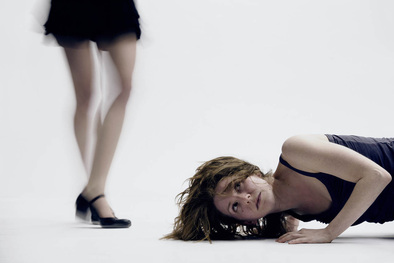 Les Mioles (REMIX), photo by Adrienne Surprenant Les Mioles (REMIX), photo by Adrienne Surprenant I email Nancy who emails Adam who emails me. In between, who knows what happens? I’m not sure if Nancy’s words are her own or if Adam has tampered with them. I might have modified what Adam sent me. Here is an interview where none of us should be held accountable for what we might or might not have said. Date: Wed, 9 Apr 2014 14:32:09 -0400 From: Sylvain Verstricht To: Nancy Gloutnez Hi Nancy, I'm so sorry I dropped the ball on this interview. Sometimes I just feel so overwhelmed with all these things I love but that I do for free, and I don't even have a job! How do you manage doing what you love and making a living? Date: Wed, Apr 9, 2014 at 8:46 PM From: Nancy Gloutnez To: Adam Kinner Salut Adam, Je me demande souvent si la bergère en moi aurait fini par faire une chorale de ses moutons ou juste une grande mozaïque de balles de laine. Toi, qu'aurais-tu fait? Date: Thu, Apr 10, 2014 at 6:29 PM From: Adam Kinner To: Sylvain Verstricht Nancy seems to think that simultaneously doing what she loves and making a living has to do with being a shepherdess of sheep. I am sympathetic to this idea. I often think that the job of the choreographer is to be some kind of shepherd, giving some direction, some discipline, some organization, some structure to the chaotic ideas, bodies, trainings, materials that performers (myself included) bring to the process. How to turn that stuff into money is a whole other problem, but the image of shaving seems apt. The shepherd captures and capitalizes the excess, but not the essence of the animal. For choreographers, I think we (they) are more needy. For Nancy, the question is whether to make a choir of the sheep or to display them as balls of yarn. For me, the question seems to be whether the sheep need to know that they are the dancers, and then further, if the presenters of dance need to know. What do you think? Can the dance of the sheep go unnoticed or does it need to be presented in a black box in order for it to register as the art-work it is? Also, is this how the interview is supposed to go? Date: Thu, 10 Apr 2014 19:48:36 -0400 From: Sylvain Verstricht To: Nancy Gloutnez I've always thought that human beings were excessively androcentric when it came to (well, everything) the parameters of art. It's like these studies that have been coming out that established that, besides humans, only parrots and Asian elephants can dance because they're on the beat about 25% of the time. The ability to pick out a beat seems as arbitrary a way to define what constitutes dance as any. Also, it seems that the more freedom one is given, the more one feels anxiety about what is expected of them (re: Adam's question about how this interview is supposed to go). Yet, that's (what comes before) the starting point of any art project, which – to be fair – can come with its own share of anxiety. Nancy, does it help you that you studied music and that you work with jig? Is the sound of the steps always your starting point? Or do you sometimes begin with visual ideas? Date: Thu, Apr 10, 2014 at 9:53 PM From: Nancy Gloutnez To: Adam Kinner I always start with the idea of an energy I want to portrait. I find that music gives me more freedom to do that than any other form of art. Through formal organization of musical ideas, and having people step dancing them, other images stand out and that's when the fun begins... Jig for me is a medium to grow closer to music. As a step dancer, I find that putting more attention to the sound (in the way a musician would) substantiates jig. In Les Mioles, I like that the body performs with the same simplicity and sobriety as a musician. I like to think it gives space for the audience to hear and hopefully feel jig differently. Also, I love grey zones, ambiguity, searching for the thin line... I have a very hard time finding that with concrete visual elements at the start, for now anyway. I'm far more anxious about making sure I articulate my thoughts properly when it comes to talking about my work to anyone uninvolved in it. Even though I'm well aware of the importance of that part in my role as a choreographer, a part of me strongly resists intellectualization. Adam, what's that like for you? Date: 1:13 PM (1 hour ago) From: Adam Kinner To: Sylvain Verstricht I always start with an idea. I'm also a context junkie. So, I always start with an idea and a context. Sometimes the context is not fully formed and has to be invented. Sometimes the idea is not fully formed and has to be invented. But the work always comes from some conceptual place (the idea) and that conceptual place is always related to the context. So with the remix it’s very clear: the idea is to rework someone else's material and the context is a 10-minute piece that follows the original, to be presented in a dance studio. For me, the work comes out of finding a way of approaching these elements ethically. Yes, ethics. Something about the way that bodies are used, the way that people are organized, the notion of "working" in dance. These are ethical issues more than artistic ones, somehow. So for some reason the work follows the ethics. After that it's just trying to take some kind of pleasure with the material. But I'm with Nancy in that I never start with concrete visual elements. But, differently from Nancy, I like to intellectualize the work, and I feel committed to exploring work both from a kind of aesthetic perspective and from an intellectual one. Sylvain, do you make work? If so, where do you start? I do make work. I write. Often, something internal is preventing me from writing. More and more, the only way for me to start is by writing about why I can’t write. I’d say that’s the thread that goes through all my most recent work. REMIX April 12 at 6pm & April 13 at 4pm Studio 303 www.studio303.ca 514.393.3771 Tickets: 10-20$ 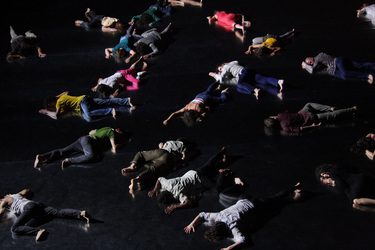 Levée des conflits, photo by Caroline Ablain Levée des conflits, photo by Caroline Ablain As my years as a dance critic pile on, it’s probably to be expected that I see more and more works I’ve already seen. This year, I can think of at least five off the top of my head. The one that most stood up to a repeat viewing was Matija Ferlin and Ame Henderson’s The Most Together We’ve Ever Been. I took the bus to Ottawa to see it just as a snowstorm was hitting the city. The ride ended up taking four hours. I barely had enough time to shove some of the worst food I’ve ever had in my mouth before running over to Arts Court, an old courthouse that has been turned into a beautiful art space. And, as soon as the show started, I knew it was all worth it. Back in Montreal, Israeli choreographer Sharon Eyal made a much-anticipated return after six years with Corps de Walk, a show she created with her partner Gai Behar. The uniformity she imposed on the twelve dancers of Norway’s Carte Blanche was oppressive and disturbing. It was its own indictment of homogeneity. At the Biennale de gigue contemporaine, the always reliable Nancy Gloutnez stood out yet again. With Les Mioles, she borrowed from classical music and became a conductor, turned her dancers’ feet into instruments, and composed a score reminiscent of Steve Reich in its obsessive build-up. After years of being one of the most rigorous emerging choreographers in Montreal, Sasha Kleinplatz has now fully emerged with Chorus II. The audience stood above six male dancers who swayed between demonstrations of physical strength and chill-inducing vulnerability. It is now up to venue artistic directors everywhere to shine on Kleinplatz the spotlight she so clearly deserves. Speaking of which, 2013 was the year of Agora de la danse. They probably had their best programming since I started following dance. It all began with Karine Denault’s Pleasure Dome, in which musicians and dancers explored pleasure without ever lazily resorting to shortcuts. Rather, she allowed the meaning of the work to emerge on its own and for Pleasure Dome to impose itself by the same token. It was followed by When We Were Old, a duo by Québec’s Emmanuel Jouthe and Italy’s Chiara Frigo (presented in collaboration with Tangente). The choreographer-dancers managed to bypass every single contemporary dance cliché that usually occurs as soon as a man and woman are onstage. In each and every moment, their encounter felt fresh and sincere. Agora ended the year with Prismes by Benoît Lachambre, who a month later would win the Montreal Dance Prize. Created for Montréal Danse, Prismes explored the effect of light on perception in a chromatic environment, as well as the fluidity of gender. Lighting designer Lucie Bazzo outdid herself for this highly experiential work. At the Festival TransAmériques, it was French choreographer Boris Charmatz who stood out with Levée des conflits, an opus of twenty-five movements repeated as a canon by twenty-four dancers. From the simplicity of the choreography to the high number of performers, Levée des conflits impressively hovered between minimalism and excess. I spent the summer in Iceland, where my trip ended with the Reykjavík Dance Festival. There, Norway’s Sissel M Bjørkli presented one of the most singular shows I’ve ever seen with Codename: Sailor V. It took place in a tiny space, barely big enough to seat fifteen. The smoke that filled the room along with Elisabeth Kjeldahl Nilsson and Evelina Dembacke’s intensely saturated coloured lighting blurred the edges of everything. Inspired by anime, Bjørkli created an alter ego for herself and through imaginative play managed to turn an office chair into a spaceship. That shit was magical. So was Nothing’s for Something by Belgium’s Heine Avdal and Yukiko Shinozaki, which opened with a ballet for six curtains, each suspended by six huge helium-filled balloons. Set to classical music, it was reminiscent of Disney’s Fantasia. For its finale, eight such balloons were left to float around the room while emitting breathing sounds, appearing like disembodied alien visitors. Soon after my return to Montreal, Marie Chouinard presented Henri Michaux : Mouvements. The genesis of this work, when Carol Prieur first incarnated the drawings of Henri Michaux back in 2005, is the reason why I’m a dance critic today. Seeing the twelve dancers of Chouinard’s company lend themselves to the exercise was just as riveting eight years later. By translating drawings into movement, Chouinard demonstrated the power of dance to think the body creatively. Usine C ended the year on a high note with their program from the Netherlands, most especially Ann Van den Broek’s feminist work for three female dancers, Co(te)lette. The show was powerful in its exposition of women’s bodies as a site of tension, torn between being objects of desire and embodied subjects. We can only hope that there will be more works like it in 2014. 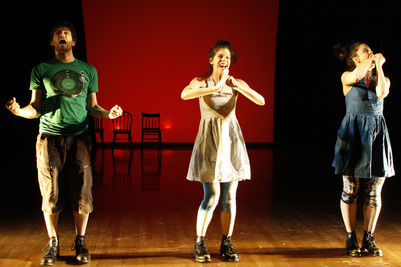 Dans sa tête de Maïgwenn Desbois, photo de Mathieu Bibeau-Lancelot Dans sa tête de Maïgwenn Desbois, photo de Mathieu Bibeau-Lancelot Si la tendance se maintient, je serais prêt à prédire que Noémie Azoulay, Élisabeth Pelletier-Ouimet et Mélissandre Tremblay-Bourassa se démarqueront de leurs confrères lors de la deuxième et dernière semaine de la 4e Biennale de Gigue Contemporaine (BIGICO). C’est que, lors de la première semaine, l’écart entre les œuvres chorégraphiées par les femmes et celles des hommes était si flagrant qu’il en est difficile à expliquer. Pour la première pièce, (im)pulsion, Olivier Arseneault a tenté de rendre la gigue sexy en la mariant au mouvement acrobatique et en passant par quelques phrases de breaking. Il manque toutefois à (im)pulsion le désir de faire plus qu’impressionner de par l’athlétisme de ses trois interprètes masculins. Le duo White noise de Pamela Poulin éprouve quelques difficultés à s’établir dès son commencement, mais parvient à composer une image surréelle en empilant couche après couche d’éléments éclectiques. Musique électronique, néons, cache-oreilles blanc, tops de coiffeuses de banlieue, tapis gazon, et gigue… Aucun trip de drogue ne peut préparer à ça. Répercussions de Philippe Meunier souffre des mêmes défauts que toutes les pièces chorégraphiées par ses confrères. Malgré sa performance enthousiaste, la scène demeure vide, la gigue étant présentée comme un tout plutôt que comme un élément parmi plusieurs dans la performance scénique. L’éclairage et la musique ne semblent qu’affixés à la performance et ne parviennent pas à y faire partie intégrale. (En fait, aucun éclairagiste n’est crédité dans le programme de la soirée, et ce pour aucune des pièces.) On devrait engager Anne Thériault comme œil extérieur. Le directeur artistique de BIGICO, Lük Fleury, présente trois courtes pièces. Chairtown est la plus réussie, même si les chaises-bâtiments de l'ébéniste Louis Gloutnez volent la vedette à la danse. Fleury ne s’assoit jamais sur ces chaises de bois, préférant plutôt les faire virevolter autour de son corps. La tension est palpable, les spectateurs priant qu’elles ne lui glissent pas des mains. Fleury démontre toutefois le pire jugement en ce qui concerne l’éclairage. Lumières bleues, rouges, et vertes; néons; découpage en forme de mots-croisés, de vitraux, et de pissenlits… Comme quoi on peut en faire trop. Avec Études de sol majeur (pour sol solo), la charmante Nancy Gloutnez offre une pièce sans accompagnement musical qui est honnête, simple, et subtile. Dans sa tête, de Maïgwenn Desbois, est la pièce la plus réussie de cette première semaine. Elle parvient à juxtaposer une multitude d’éléments, créant ainsi un environnement riche. Trois chaises en arrière-scène où les interprètes (dont un a le syndrome d’Asperger et une autre le syndrome de Williams) font du body clapping en nous tournant le dos, et un spot de lumière à l’avant-scène, une zone d’exutoire comportemental. Dans sa tête a l’aspect ludique d’un rêve, les interprètes apparaissant tels des héros victimes de leur subconscient, aux réactions hors de leur contrôle, mais prêts à affronter leurs peurs. Notons particulièrement la performance disjonctée de Gabrielle Marion Rivard. Au fil des années, il devient de plus en plus évident qu’il serait bénéfique pour BIGICO de se concentrer sur les meilleures productions et de se limiter à une semaine plutôt que deux. La deuxième semaine de BIGICO inclut aussi des pièces de Jean-Philippe Lortie et Ian Yaworski. 4e Biennale de Gigue Contemporaine Semaine 2 : 7-9 avril à 19h30; 10 avril à 16h Tangente www.tangente.qc.ca 514.525.1500 Billets : 18$ / Étudiants : 14$ |
Sylvain Verstricht
has an MA in Film Studies and works in contemporary dance. His fiction has appeared in Headlight Anthology, Cactus Heart, and Birkensnake. s.verstricht [at] gmail [dot] com Categories
All
|
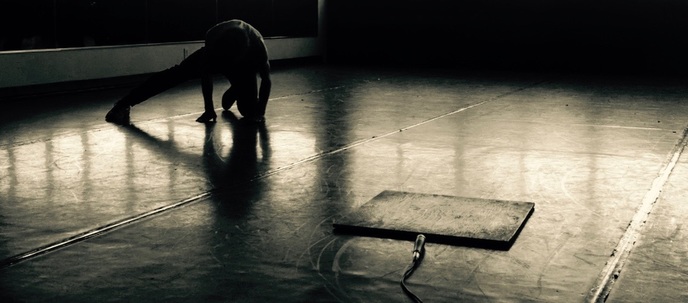
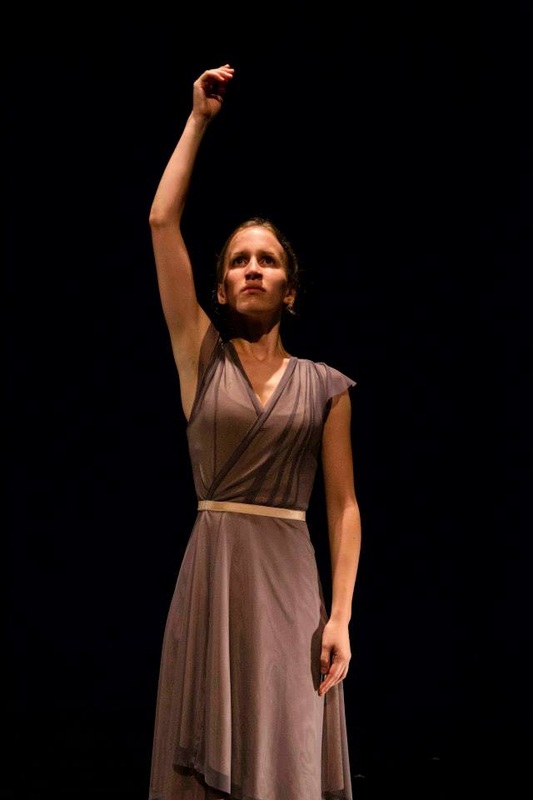
 RSS Feed
RSS Feed